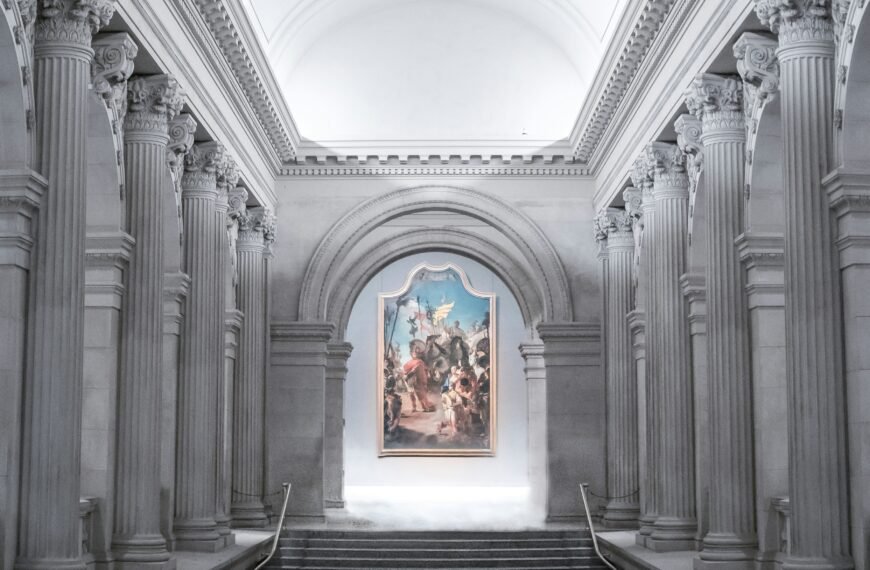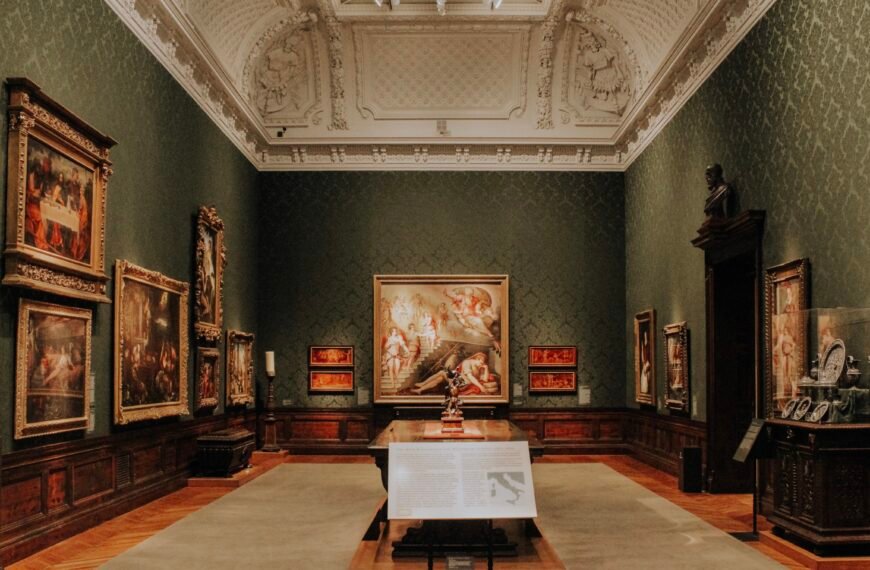Located in the heart of New York City, the iconic Guggenheim Museum stands as a marvel of modern architecture and a hub of artistic expression. Nestled on Fifth Avenue, amidst the bustling streets and towering skyscrapers, the Guggenheim Museum beckons visitors to explore its world-renowned collection of contemporary and avant-garde art. Whether you are an art enthusiast or just appreciate the beauty of creativity, this cultural landmark is a must-visit, promising an immersive experience that will leave you awe-inspired and enchanted.

History
Founding
The Guggenheim Museum, also known as the Solomon R. Guggenheim Museum, was founded in 1937 by Solomon R. Guggenheim and his advisor, Hilla von Rebay. The vision for the museum was to create a space that would showcase contemporary art and challenge traditional forms of display. Its unique spiral shape and innovative architecture would become synonymous with the Guggenheim name.
Architect
The iconic design of the Guggenheim Museum was the brainchild of renowned architect Frank Lloyd Wright. Wright’s vision was to create a building that would be a work of art in itself, blending seamlessly with its surroundings. His use of a continuous spiral ramp instead of traditional floors allowed visitors to experience art in a completely new way.
Design
The design of the Guggenheim Museum is as innovative today as it was when it first opened its doors. The building’s exterior features a striking white concrete facade, which contrasts beautifully with the surrounding cityscape. The interior is equally impressive, with a spiral ramp that winds its way up from the ground floor to the top of the building. This design allows visitors to view the art from multiple angles and perspectives, creating a unique and immersive experience.
Location
City
The Guggenheim Museum is located in the vibrant city of New York. Situated on the Upper East Side, it is just a short distance from Central Park and other famous landmarks. The museum’s location in such a culturally rich city ensures that it is easily accessible and draws visitors from around the world.
Address
The exact address of the Guggenheim Museum is 1071 5th Ave, New York, NY 10128, United States. Its prime location on Fifth Avenue means that it is in close proximity to other iconic museums and attractions in the city.
Landmarks
In addition to its own architectural significance, the Guggenheim Museum is surrounded by other notable landmarks. Just across the street is Central Park, offering visitors the opportunity to enjoy a leisurely stroll and take in the natural beauty of the city. The Metropolitan Museum of Art and the Museum of Modern Art are also nearby, providing art enthusiasts with a wealth of cultural experiences in one area.
Architecture
Style
The architecture of the Guggenheim Museum is often described as “organic” or “organic architecture.” Frank Lloyd Wright’s design is characterized by its emphasis on harmony with the natural surroundings. The building’s flowing lines and curved forms create a sense of movement, while the extensive use of glass brings in natural light and connects visitors to the outside world.
Famous Features
One of the most famous features of the Guggenheim Museum is its spiral ramp. This innovative design allows visitors to seamlessly navigate the museum and experience the art in a continuous flow. The central atrium, known as the rotunda, serves as the focal point of the building, with galleries branching off from it on each level. The skylight at the top of the rotunda bathes the space in natural light, creating a serene and inviting atmosphere.
Exhibitions
Permanent Collection
The Guggenheim Museum is home to an impressive permanent collection that spans a wide range of artistic mediums. From paintings and sculptures to multimedia installations, the museum’s collection represents a diverse range of artistic movements and periods. Visitors can explore works by iconic artists such as Pablo Picasso, Jackson Pollock, and Vincent van Gogh, among many others.
Temporary Exhibitions
In addition to its permanent collection, the Guggenheim Museum regularly hosts temporary exhibitions that showcase cutting-edge contemporary art. These exhibitions often focus on specific themes or highlight the work of emerging artists. The museum’s commitment to showcasing innovative and thought-provoking art ensures that every visit offers a fresh and engaging experience.

Collections
Artwork
The artwork housed within the Guggenheim Museum’s collections is as diverse as it is impressive. Visitors can expect to see masterpieces from various artistic movements, including abstract expressionism, pop art, and surrealism. The museum’s collection includes notable works such as Picasso’s “Woman Ironing” and Kandinsky’s “Composition 8,” each offering a unique perspective and telling its own captivating story.
Artists
The Guggenheim Museum has been instrumental in promoting and supporting both established and emerging artists. Over the years, it has showcased the works of groundbreaking artists such as Yayoi Kusama, Jean-Michel Basquiat, and Jenny Holzer. These artists have pushed the boundaries of traditional art forms and have left an indelible mark on the art world.
Significance
The Guggenheim Museum’s collections hold immense significance in the art world. They represent not only the artistic achievements of individual artists but also the progression of artistic movements throughout history. By displaying these works, the museum not only preserves artistic heritage but also educates and inspires visitors to appreciate the power of art to shape culture and ignite change.
Visiting Information
Opening Hours
The Guggenheim Museum is open to the public six days a week, from Monday to Saturday. Its opening hours vary slightly depending on the day, with extended hours on certain days to accommodate different schedules. Visitors are advised to check the museum’s website for the most up-to-date information regarding opening hours.
Admission Fees
As a non-profit institution, the Guggenheim Museum relies on admission fees to support its operations and maintain its collections. General admission tickets are available for purchase, and discounted tickets are offered to students, seniors, and members of the military. There are also free admission days throughout the year, providing an opportunity for everyone to experience the museum.
Guided Tours
To enhance the visitor experience, the Guggenheim Museum offers guided tours led by knowledgeable and passionate staff. These tours provide insights into the museum’s architecture, collections, and exhibitions, allowing visitors to deepen their understanding and appreciation of the art on display. Private tours and audio guides are also available for those who prefer a more self-guided experience.

Accessibility
Facilities
The Guggenheim Museum is committed to providing a comfortable and inclusive experience for all visitors. It offers a range of facilities, including accessible restrooms, elevators, and ramps, to ensure that everyone can navigate the museum with ease. Additionally, the museum has a gift shop and café where visitors can take a break and enjoy refreshments.
Services for Visitors with Disabilities
In line with its commitment to accessibility, the Guggenheim Museum offers services specifically tailored to meet the needs of visitors with disabilities. These services include sign language interpretation, assistive listening devices, and accessible tours. The museum’s staff is trained to provide assistance and support, ensuring that everyone can fully enjoy their visit.
Nearby Attractions
Landmarks
The Guggenheim Museum’s location in New York City’s Upper East Side puts it in close proximity to several other iconic landmarks. Visitors can explore the grandeur of Central Park, visit the nearby Metropolitan Museum of Art, or marvel at the masterpieces in the Museum of Modern Art. The neighborhood itself is rich in history and charm, with beautiful architecture and renowned cultural institutions.
Restaurants
After immersing yourself in the world of art, a visit to one of the many nearby restaurants is a must. With a wide variety of cuisines and dining options, there is something to satisfy every palate. From trendy cafes to fine dining establishments, the area surrounding the Guggenheim Museum offers a culinary experience that is sure to delight.
Parks
For those seeking a moment of respite amidst the hustle and bustle of the city, there are several parks in close proximity to the Guggenheim Museum. Central Park, with its sprawling green spaces and scenic pathways, provides a peaceful retreat for visitors. Other nearby parks, such as Carl Schurz Park and John Jay Park, offer beautiful views of the East River and opportunities for outdoor activities.
Future Plans
Upcoming Expansion
The Guggenheim Museum has plans for an expansion that will further enhance its facilities and exhibition space. This expansion will allow for the display of an even greater number of artworks and create new opportunities for engaging with the museum’s collections. The design for the expansion is in line with the visionary spirit of the museum, seeking to create a space that is both functional and aesthetically striking.
Special Projects
In addition to its expansion plans, the Guggenheim Museum continues to undertake special projects that push the boundaries of traditional art exhibitions. These projects often involve collaborations with artists and organizations from around the world, resulting in unique and thought-provoking experiences for visitors. The museum’s commitment to innovation ensures that there will always be something new and exciting to discover.
Conclusion
Impact
Since its founding, the Guggenheim Museum has had a significant impact on the art world and the cultural landscape of New York City. Its unique architecture, engaging exhibitions, and diverse collections have made it a beacon for artists and art lovers alike. Through its commitment to showcasing groundbreaking works and promoting artistic innovation, the museum continues to shape the trajectory of contemporary art.
Relevance
In an ever-changing world, the Guggenheim Museum remains relevant by embracing new ideas and perspectives. By hosting temporary exhibitions and supporting emerging artists, the museum fosters a dynamic and inclusive environment that reflects the evolving nature of the art world. Its dedication to accessibility ensures that everyone, regardless of background or ability, can engage with and appreciate the power of art.
Future
As the Guggenheim Museum looks towards the future, its mission to inspire, educate, and challenge continues to guide its endeavors. With upcoming expansions and special projects on the horizon, the museum is poised to further expand its reach and impact. By pushing the boundaries of traditional art institutions, the Guggenheim Museum will undoubtedly shape the future of contemporary art for generations to come.








